how to grind coffee without a coffee grinder
Sip Coffee House is reader-supported. If you purchase through a link on this site, we may earn a commission at no extra cost to you. Learn more.
Oh no! You go to grind your whole bean coffee early one morning. You press the button on your electric burr grinder, and it…does nothing. A dark, dreadful silence. Grinder death.
What do you do? You need coffee NOW, and you don't have a backup grinder nor a coffee shop in sight. Can you grind coffee beans without a grinder?
Yup…You can!
In this article, I'll go over how to grind coffee without a grinder in 7 different ways using common kitchen tools. Which will you use? That decision is up to you.
Smash Coffee Beans With A Pestle & Mortar
Many people have a mortar and pestle in their kitchen. Perhaps you're used to crushing spices and herbs in it. But will a mortar and pestle work to grind coffee beans? Yes!
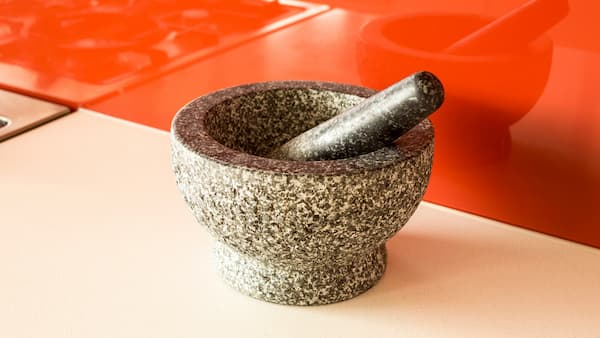
When you use a mortar and pestle as a coffee grinder, you won't get as even a grind as when you use a burr grinder or even an electric blade grinder. But it is an effective alternative if you don't have access to those grinders.
For this grinding method, start with a small amount of beans. That will ensure as consistent a grind as possible without excessively grinding some particles. A ceramic mortar will get you better results than a wood or metal one.
You can get as a fine grind as you want. It all depends on how much elbow grease you're willing to put into the process. Just remember, if you want to go much finer than drip coffee for multiple cups, it's going to require serious work.
Overall, grinding for a crowd would be a bit exhausting using a mortar and pestle, so this is better suited for 1 cup of coffee.
Overall, grinding for a crowd would be a bit exhausting using a mortar and pestle, so this is better suited for 1 cup of coffee.
How do you do it?
Step 1
Add a small scoop of your beans to your mortar. Depending on the size mortar you have, you might want to add two scoops.
Step 2
Use the pestle to carefully crush the beans until you see a consistent grind, about that of kosher salt.
Step 3
Empty out the coffee and start with a new batch.
With A Rolling Pin
Most people also have a rolling pin in their home, or at least a cylindrical glass bottle. You can use your rolling pin as a makeshift coffee grinder, although you won't get an even grind.
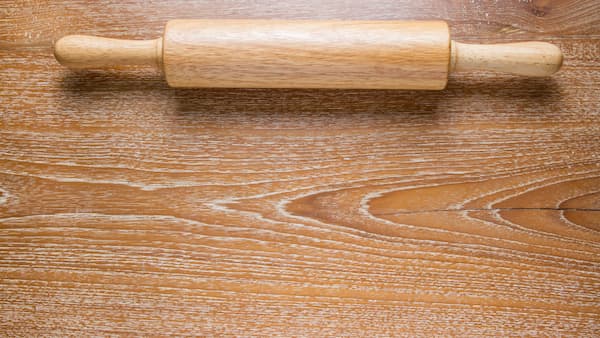
Remember that if you're not careful, you can wind up with bits of coffee everywhere. That's why I recommend using plastic under and above the beans. The plastic or parchment you use to grind beans will be in bad shape afterward.
To grind coffee with a rolling pin, you'll need the rolling pin, a plastic bag, plastic cling wrap or parchment paper, and patience.
How do you do it?
Step 1
Lay a sheet of plastic on your kitchen counter.
Step 2
Place a layer of coffee beans on the plastic.
Step 3
Cover beans with a top layer of plastic. (Or place the beans inside a freezer bag that's sturdy enough to hold up to the job). You can also use parchment paper if you wish and only want to grind a small amount of coffee.
Step 4
Roll your rolling pin over the beans, back and forth.
Step 5
Continue passing the rolling pin back and forth over the beans until you have the desired consistency of coffee grounds.
Grind Beans Mechanically With A Food Processor
If the mere thought of pressing and grinding coffee beans by hand makes you feel tired, you might be looking around your kitchen wondering what other electric appliances could do the job.
And then you spy your food processor, deciding it's going to do the work for you.
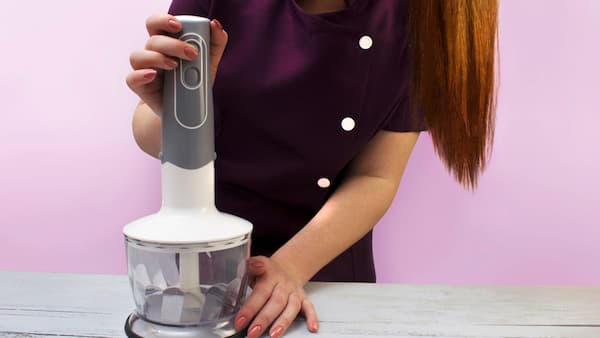
It does sound a lot easier just to pop the coffee beans in your food processor and avoid manual grinding. But I'll tell you from the start that the results might not be as optimal as you'd like.
There are three problems you'll face if you use food processors to grind your beans: consistency, grind size, and heat.
It will be tough to get a consistent grind. Also, you shouldn't expect to get fine coffee grounds. And food processors heat up the beans and produce bitter flavors in your brew.
You might want to consider brewing the coffee in a French Press, which will extract the grounds slower than other methods.
If you want to give your food processor a try, here are the steps. All you'll need is the food processor, coffee beans, and a bowl.
How do you do it?
Step 1
Place coffee beans in a food processor.
Step 2
Cover the top of the food processor.
Step 3
Grind beans in the pulse setting for short bursts.
Step 4
Empty and repeat until you have enough coffee grounds.
Grind Coffee Beans With A Blender
Can you use a blender as a coffee grinder? Yes.
Is it the best thing for the life expectancy of your blender? Probably not.

Most blenders are designed to blend liquids. When you add dry items, many blender motors just can't take the friction. Also, hard coffee beans are going to wear down your blender blades.
A blender is not going to give you a consistent or fine grind. Additionally, the heat generated by the blades will make your brew taste bitter.
But if grinding your coffee in a blender is the best option you have, here are the steps to get the best results.
How do you do it?
Step 1
Place a small amount of coffee beans in a dry blender. Add enough to cover the blades completely, but not so much that you can't control the consistency.
Step 2
Place the lid on the blender. This is an important step – you don't want coffee all over your kitchen.
Step 3
Adjust the blender to a medium setting.
Step 4
Turn the blender on. Use the blender in a pulse setting – don't run the engine for long periods.
Step 5
When you achieve the best grind possible, empty the coffee grounds.
Step 6
Let your blender cool down if necessary.
Step 7
Start with a new batch if you need more coffee grounds.
Squash Whole Bean Coffee With A Flat Edge Knife
Is grinding coffee beans with a knife possible? Yes, you can use a knife, like a butcher knife, to grind beans. Obviously, I'm not encouraging you to slice your coffee beans like you'd slice tomatoes. But you can use the flat edge of your knife to crush the beans.
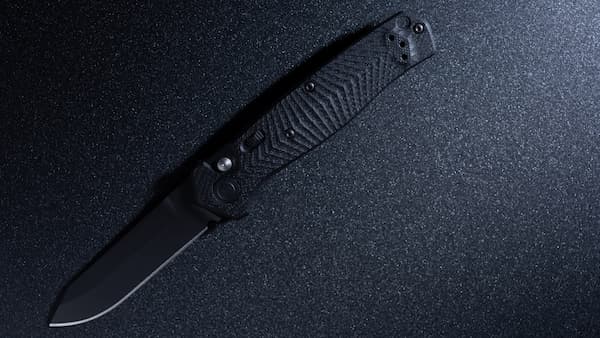
I do this all the time to crush garlic. So it should work with coffee beans, right? Right?
When you try it out, you will soon discover that crushing soft garlic is a whole different world than crushing very hard coffee beans.
Be extremely careful not to cut yourself in this process. If you're not used to handling a knife, I suggest you skip this option so you can avoid an emergency trip to the hospital.
Don't expect even remotely consistent coffee grounds. At best, you'll get a coarse grind suitable for French press or a cup of cold brew and not your drip coffee maker. This method is only for the truly desperate who have no other choice.
You will only need a cutting board, coffee, and a broad edge knife (like a chef knife or butcher knife).
How do you do it?
Step 1
Place beans on a cutting board
Step 2
Lay the flat edge of a broad knife on top of the beans
Step 3
Press down firmly until you crush the coffee beans. If the beans scatter, you can use paper towels to keep them in place.
Use a garlic press
A garlic press is a manual device that uses lever action to exert pressure on garlic and force it through tiny holes. In the process, the garlic gets pressed.
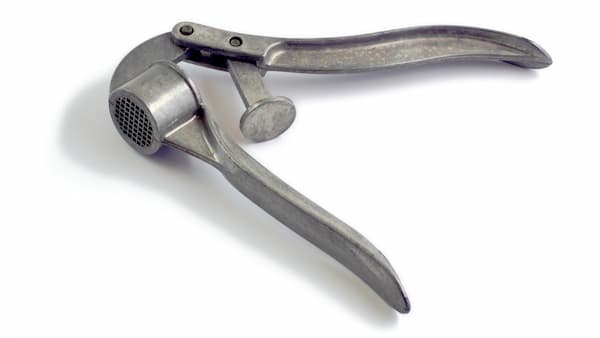
Can you use a garlic press for coffee? Yes. But be aware that you will have to exert huge amounts of pressure to get the coffee beans through the holes. This may work better with dark roasted coffee, which has a weaker cell structure.
Also, be sure to clean your garlic press thoroughly before using it to press coffee, so you don't get garlic-flavored coffee.
How do you do it?
Step 1
Add a small amount of coffee beans to a clean garlic press.
Step 2
Use the lever to press the coffee beans carefully. Make sure you do this over a plate or bowl to catch the ground coffee.
Step 3
If necessary, put the coffee grounds back in the press and press again until you see a consistent size, around the size of kosher salt.
Step 4
Empty out the coffee and start with a new batch.
Use A Hammer To Grind Coffee Beans Without A Grinder
If you don't have any of the above, you can always turn to the last resort of the truly desperate coffee drinker. A hammer.

This is not my favorite method for coffee grinding, which is why it's last on the list. Use it only if you have no other choice or want a fun story to tell to friends.
Naturally, when you hammer at coffee beans in an attempt to grind them, you won't get an even grind. Some pieces will be large, and you'll also produce quite a bit of powder.
Now, don't picture yourself hammering away wildly. Your goal is to use the head of the hammer to crush the coffee beans. Visualize a slow crushing movement.
Start in one corner or spot and move methodically over the beans to avoid crushing some areas more than necessary.
Avoid hammering on your kitchen counter or another surface that you're fond of to avoid any damage.
To grind coffee with a hammer, you need the hammer (or meat tenderizer), coffee beans, a plastic zip bag, and some elbow grease. You'll also need a firm surface to do your coffee hammering.
How do you do it?
Step 1
Place beans in a plastic zip bag.
Step 2
Press the head of the hammer on one section of beans.
Step 3
Gently but firmly press on the beans with the hammer until you crush the beans.
Step 4
Move to the adjacent area. Continue until you finish crushing all the beans in the bag.
Coffee Grinding Consistency Issues
Now that we've run through the list of what you can and cannot do to grind coffee beans without a grinder, you may be asking yourself if these methods are the best ways to treat your beloved beans.
And the answer is that they're not. You may be better off making an emergency trip to your local supermarket or store and buying pre-ground coffee. At least that way, although you won't have freshly ground coffee, you will have coffee grounds with a consistent size.
It's essential to have an even grind size when brewing coffee. When smaller particles of coffee beans that have a greater surface area come into contact with water, they extract faster. A larger particle size takes time to release flavor, sweetness, and body from your grounds.

So if you make a brew with ground coffee that's wildly uneven, some of your coffee grinds are going to over-extract (think bitter) while others won't even have entered their flavor-releasing stage.
A possible outcome is that you'll wind up with a bitter cup of coffee that has precious little body. Depressingly little sweetness. And we won't even mention acidity.
But desperate times call for desperate measures. Let's say you went camping and didn't realize your electric grinder won't work in an electricity-free cabin. You may find yourself frantically searching for a way to grind coffee beans without a grinder. There's no convenience store just down the road, and you really need that cup of coffee.
That's a moment when a hammer or a leftover soda bottle may seem like a heaven-sent blessing. So go for it, grind beans without electricity using an unconventional method. And enjoy a cup of coffee that, while it won't be the tastiest one, it will be a morning cup to remember.
Wrapping Up: How to grind coffee without a grinder
In conclusion, I have to say I've never been trapped without a coffee grinder. I'm a bit paranoid about this happening, so I have several electric grinders and two manual grinders at home.
When I travel, I take a bit of ground coffee with me and a manual grinder.
If you would rather not live such a paranoiac coffee existence, you may at some point find yourself in the position of needing a method to grind coffee beans without a grinder.
In that case, I suggest you go for the mortar and pestle method. The mortar will hold the coffee in place while you firmly press it with the pestle. You can see where you need to grind a bit more, and you can easily empty out any finely ground beans.
If you don't have a mortar and pestle, the runner-up would be the rolling pin method. If you don't have a rolling pin, reach for any cylinder-shaped bottle or glass container to grind.
Frequently Asked Questions
Can you use a blender to grind coffee?
Yes, you can use a blender to grind coffee. Just be careful to use small amounts of coffee so that you don't overload your blender. Grinding coffee beans in small batches also ensures that you can control the consistency of the grind a bit better. Remember, a blender isn't going to deliver a fine grind suitable for espresso machines.
How do I make instant coffee without a grinder?
True instant coffee is first brewed and then freeze-dried. That generally isn't possible in a home kitchen. However, you can use any of the above options to grind your coffee very fine, add hot water, and brew for 2 minutes. Then pour off the coffee either with a fine sieve or a filter.
how to grind coffee without a coffee grinder
Source: https://sipcoffeehouse.com/how-to-grind-coffee-without-a-grinder-7-different-ways/
Posted by: markssugh1947.blogspot.com

0 Response to "how to grind coffee without a coffee grinder"
Post a Comment